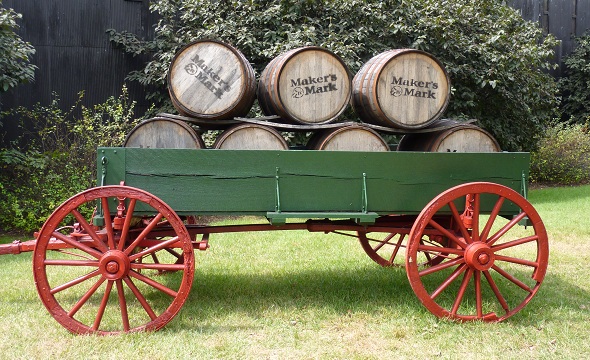The Maker’s Mark Distillery in Loretto, Kentucky is one of the most picturesque distilleries in the country. It feels uniquely American, almost like you just stepped inside a Norman Rockwell painting, except with more of a bourbon-y vibe.
The distillery property is 750 acres and the distillery itself is over 200 years old, but it wasn’t until 1953 that Maker’s Mark was born. Bill Samuels spent six years developing what he considered to be a smoother, more drinkable whiskey. He was looking for an alternative to the industry standard.
[new_royalslider id=”5″]
“He was trying to find a different way from what the family had always done, what the industry had only ever done before… which was large quantity, rough, test-of-manhood whiskey,” said Rob Samuels, President of Maker’s Mark and grandson of Bill Samuels.
Maker’s Mark has played an important role in the American spirits story. It’s one of the first American whiskeys that focused on a specific taste profile that subtracted the aggressiveness of traditional American whiskeys. Bill Samuel’s goal was to create a softer, more balanced bourbon that focused on flavor and drinkability.
Unlike most American whiskeys, Marker’s Mark does not use rye. Maker’s is composed of 70% corn, 16% red winter wheat and 14% malted barley. Once the grains are processed, they’re blended with water from Maker’s own spring-fed limestone lake. During our tour we were told that Maker’s Mark is the only distillery to exclusively use limestone-purified water.
While leading us around the grounds and distillery, Rob Samuels kept joking that Maker’s Mark is a model of inefficiency by choice. One of the more unique “inefficiencies” is the rotation of barrels during their roughly five year and nine month aging process. Each barrel begins aging at the top of the warehouse, where the most intense maturation occurs. They are then moved to the middle of the warehouse and, eventually, to the bottom rack. Samuels tells us that they are the only distillery in the world that rotates their barrels throughout the entire aging process.
“We have to leave 25% of our warehouses empty. We’re building new warehouses now, but nearly a third of our warehouses are empty, because when you move a barrel you need somewhere to put it. We have 20 people whose only job is to move barrels. It’s incredibly inefficient,” said Samuels.
Rob Samuels took over as the President of Maker’s Mark in 2011. He’s an 8th generation whiskey maker, which is the longest American lineage. His father, Bill Samuels Jr., created Maker’s 46, which is essentially Maker’s Mark aged in a barrel with 46 staves of heavily charred oak. These staves give Maker’s 46 a smoky spiciness (think clove, cinnamon, nutmeg) that very much distinguishes itself from the traditional Maker’s Mark. It was the vision of Bill Samuels Jr. to build a new whiskey with a different flavor profile, but one that still adhered to the family’s whiskey-making traditions and values.
Maker’s Mark has been family run from the beginning, but it hasn’t been family owned in more than 30 years. It was originally sold in 1981 to Hiram Walker & Sons, and in 1987 it was sold again to what would become Allied Domeq. Then in 2005 Allied Domecq sold Maker’s Mark to Fortune Brands, where it became a part of the Beam Global portfolio.
On January 14th of this year, Suntory (a Japanese drinks company) bought Beam, Inc. The acquisition catapults Suntory from 15th in global spirits sales to 3rd, and it means that, once again, Maker’s Mark has a new owner. They’ve already survived three previous rounds of corporate ownership, and we’ve got to wonder if the traditional, family-run and self-titled “inefficient” bourbon producers can survive a fourth. We’re inclined to think so.




I enjoyed the article. The pictures make me want to pay a visit. Also, I am thinking a bottle of 46 needs to find its way into my liquor cabinet soon.